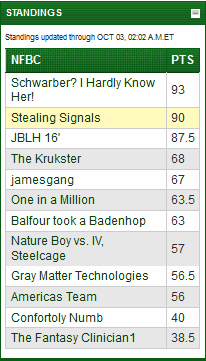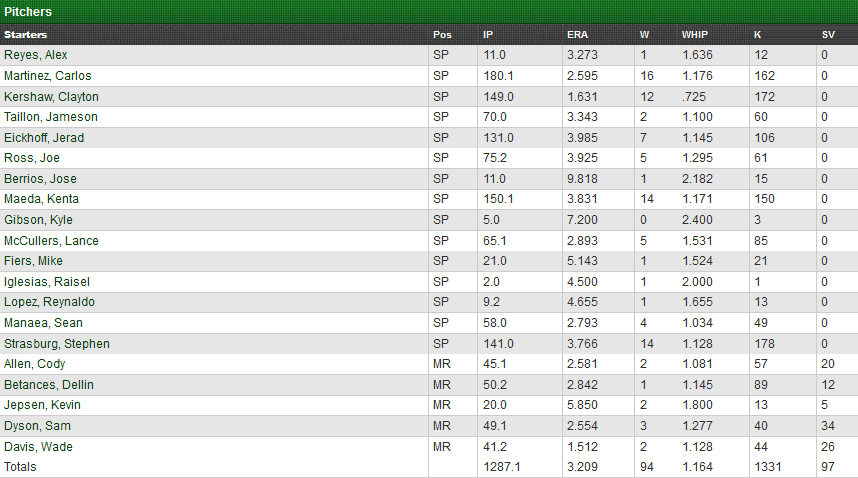2016 was my fourth year playing the National Fantasy Baseball Championship (NFBC) against some of the best fantasy baseball players in the world. In the past, I've been successful in the $150 NFBC Draft Champions format (15 teams, 50 rounds, no in-season pickups), finishing as high as 55th overall out of 2,880 teams in 2015. But the $350 NFBC RotoWire Online Championship (12 teams, 30 rounds, with in-season pickups) has always been a different story. Entering this season, I was 0-for-3 in the "OC," finishing 3rd in my league twice and 4th once in previous attempts. For those unaware, the OC awards prizes for the top-2 finishers in each league, so you can imagine the frustration I've experienced in this particular format, especially given the $350 entry fee. $350 may not be a lot to some people, but to me, it's a hefty chunk of change, or an average grocery bill for my family of five (including two very hungry teenagers). Believe me, I wouldn't be dropping that much if I wasn't confident in my abilities to hang with NFBC's finest.
Back in March, I asked myself what I could do differently to find success in the NFBC Online Championship. I'm no stats expert, so diving deep into xFIP, wOBA and other sabermetrics was not part of my agenda. That's not to say I ignored those statistics completely, but if I stare at numbers too long, I risk battling a throbbing headache that only a dose of Kershaw highlights can cure. As an alternative, I decided to it would benefit myself and perhaps other loyal readers of the RotoWire Blog to track my progress, or lack thereof, in writing.
Back on April 1, I drafted my $100k grand prize, NFBC RotoWire Online Championship team. You may remember the updates I posted at the beginning of June and August documenting my position in the league and the overall contest, the logic behind my free-agent pickups/drops, and recaps of my players' performance. Consider this blog post the final installment of my 4-part 2016 NFBC Online Championship series.
When I was typing my August update, I was sitting in 3rd place in my league, 29.5 points out of first place and 20.5 points out of second, thinking my season was over. Clayton Kershaw and Wade Davis were injured at the time. I thought I had no chance (cue Vince McMahon's theme) of turning my season around. I was mentally preparing myself for yet another 3rd or 4th place finish. Many fantasy players would have checked out under these circumstances, but I was fortunate to grow up with excellent rec-league coaches (who also happened to be my parents) who taught me to play hard no matter what, and battle to the end no matter how poorly things were going. Yes, it was a grind, but I finally accomplished a goal that had eluded me for three years prior. I cashed in the NFBC RotoWire Online Championship.
Here are the final standings of my self-proclaimed "Beat Ryan Rufe League":

I realize 2nd place is nothing to brag about. I would have loved to finish 1st in my league and place high enough in the overall standings -- I finished 144th out of 1,632 entries -- to take home an additional prize. I'll just have to work a bit harder to have a shot at that $100k next year, both in draft preparation and in-season roster management.
So how did I overcome a 20.5 point deficit to climb back into the race and nearly win the league? Let's dive in.
In years past, I used to think the FAAB process was a nightmare. I used to dread Sunday evenings, pondering how many FAAB dollars I'd have to waste on the new hot closer who likely only held onto the job for a week. This year, I found the FAAB process to be much less stressful, mainly because invested early draft picks on two reliable closers, Wade Davis and Cody Allen. I also landed Sam Dyson for cheap right before he was named closer in Texas and got save contributions from Kevin Jepsen and Dellin Betances along the way. Chasing saves is the absolute WORST. I'll probably stick with a similar plan next year and target the ultra-reliable closers early in drafts -- guys like Britton and Chapman, who will get you the saves along with elite ratios and strikeout totals.
FAAB Results (Weeks 19-26) & Observations
After submitting my August update, I only had $6 FAAB dollars to spend, so I won't go too in-depth here. In Week 19, I added Jorge Soler and Mike Fiers for $1 apiece, dropping Randal Grichuk (minors) and Cody Allen (CLE acquired Andrew Miller). I added Reynaldo Lopez for $1 in Week 20 (dropping Tim Anderson) and Raisel Iglesias for $1 in Week 21 (dropping Matt Holliday). I was lucky to nab Alex Reyes for $1 in Week 22 (dropping Lance McCullers) and in Week 24, I spent my last FAAB dollar on Andrew Benintendi (dropping Stephen Strasburg). None of these players did much for me, but I was BARELY fielding a healthy lineup and all were active for me at some point down the stretch.
Next year, I'll be more careful with how I manage my FAAB dollars through July and budget a lot more for the final two months of the season. Sure, I was still able to land some high-upside players with $6 measly FAAB dollars, but I also missed out on guys like Gary Sanchez, Edwin Diaz, Tyler Thornburg, CJ Cron, Robert Gsellman, Ryon Healy and Dee Gordon. I was also forced to start the injured Jorge Soler and Daniel Murphy over the last few weeks of the season because I was FAAB-broke and couldn't add healthy replacements.
FAAB Success Stories
Evan Gattis ($76, Week 7) - I was extremely fortunate that Gattis gained catcher eligibility when he did, otherwise I would have been stuck with AJ Pierzynski, Dioner Navarro, James McCann or Chris Herrman as my C2 behind Brian McCann.
Sam Dyson ($22, Week 7) - Contributed 34 saves to my squad, kept me afloat in the saves category when Davis was injured.
Jose Ramirez ($12, Week 9) - One of the main reasons why I was successful this season. Hit well over .300 with moderate pop, solid run production and 18 steals. And to think Derek Dietrich was my primary waiver target that week!
Jameson Taillon ($303, Week 12) - Spending $303 wasn't exactly a win, but he did give me 70 solid innings with good ratios and strikeout totals. Wins (2) were the only thing lacking.
Tyler Naquin ($2, Week 15) - Was a platoon option for the Indians and struggled down the stretch for a bit, but still hit .273 for me.
Sean Manaea ($7, Week 17) - Brilliant down the stretch, elevated his fantasy stock for next year. A big reason why I climbed back into contention.
Alex Bregman ($12, Week 18) - His disastrous first week in the majors enabled me to land him on the cheap. Bregman proceeded to go on a tear before missing 14 games in September. He's another reason why I climbed back into contention.
FAAB Busts
Kevin Jepsen ($334, Week 3) - Killed my ratios and netted only five saves over 20 innings.
Byron Buxton ($30, Week 10) - Added him for steals, but hit just .181 over 81 at-bats for me, with only 3 base swipes.
Tim Anderson ($121, Week 11) - He didn't perform poorly (he hit .274 after all), but I added him for steals and he only gave me four of those.
Trea Turner
Yes, he gets his own section. I drafted Turner in the 26th round and patiently anticipated his mid-July arrival. That patience was rewarded, as Trea single-handedly helped me gain 7 points in the stolen base category alone. Not only that, he hit .342 with 13 homers and 40 RBI while crossing the plate 53 times for Stealing Signals, giving me a boost in all 5 hitting categories. Turner also provided position flexibility (2B/OF), which was extremely helpful to me when Lorenzo Cain, Matt Holliday and Randal Grichuk (minors) all missed time in the latter months.
Draft Gems
No explanation needed for the guys I drafted in Rounds 1-4, as Kershaw, Springer, Strasburg and Votto all did what they were supposed to do. Wade Davis (Rd6) and Kyle Seager (Rd7) were steady contributors. Aside from Turner (Rd26), the true heroes for Stealing Signals were Carlos Martinez (Rd8), Stephen Piscotty (Rd13), Kenta Maeda (Rd14), Daniel Murphy (Rd16), Dellin Betances (Rd17) and Jerad Eickhoff (Rd22). Martinez paced my rotation with 16 wins and 180.1 innings pitched, while posting an impressive 2.60 ERA and 1.18 WHIP with 162 strikeouts. Piscotty entered the season with a fair amount of hype, but most (including myself) drafted Grichuk ahead of him. Nobody really knew if Maeda would make a successful transition to MLB, but he passed that test with flying colors. Murphy flat-out raked all year -- thanks Daniel! Betances was overlooked in my draft because he didn't open 2016 as the Yankees' closer, but he ended up the role anyway after Brian Cashman dealt away Chapman and Miller. Last but not least, I hated my Eickhoff pick when I made it, thinking it was a reach for someone who only had 8 big league starts under his belt at the time. He ended up being a nice surprise.
End of Season Stat-Wrap
Here's a summary of my pitching stats:

Here's a summary of my hitting stats:

Hopefully this was helpful to those who have been along for the ride over the past 6 months. I'm very passionate about the NFBC and always love talking/sharing strategy. Notice something that I could have done better? Want to share success stories/failures? Hit me on Twitter anytime.



